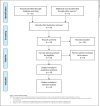Progesterone as a Neuroprotective Agent in Neonatal Hypoxic-Ischaemic Encephalopathy: A Systematic Review
- PMID: 36436500
- PMCID: PMC10129034
- DOI: 10.1159/000521540
Progesterone as a Neuroprotective Agent in Neonatal Hypoxic-Ischaemic Encephalopathy: A Systematic Review
Abstract
Hypoxic-ischaemic encephalopathy (HIE) in the newborn baby is a major contributor to neonatal mortality and morbidity across the world. Therapeutic hypothermia (TH) is the current standard treatment for moderate to severe HIE, but not all babies benefit. Potential neuroprotective actions of progesterone (PROG) include anti-apoptotic, anti-inflammatory, and anti-oxidative effects and reduction of energy depletion, tissue/cellular oedema, and excitotoxicity. In pre-clinical studies of neonatal HIE, PROG has neuroprotective properties but has not been the subject of systematic review. Here, our objective was to evaluate the evidence base for PROG as a potential therapeutic agent in HIE. The PICO framework was used to define the following inclusion criteria. Population: human neonates with HIE/animal models of HIE; intervention: PROG +/- other agents; comparison: V.S. control; outcome: pathological, neurobehavioural, and mechanistic outcome measures. Medline, EMBASE, and CINHAL were then searched between August to October 2018 using pre-defined medical subject heading and keywords. Study inclusion, data extraction, and risk of bias (ROB) analysis using the SYRCLE ROB tool were carried out by two authors. 14 studies were included in the review. They typically displayed a high ROB. This systematic review suggests that PROG reduced neuropathology and reduced neurobehavioural deficits post-hypoxic-ischaemic (HI) insult in 8 and 3 studies, respectively. However, there was sex dimorphism in the effects of PROG. In addition, there are limitations and biases in these studies, and there remains a need for well-designed large pre-clinical studies with greater methodological quality to further inform the efficacy, safety, dose, timing, and frequency of PROG administration. With such data, large animal studies could be planned combining PROG administration with and without TH.
Keywords: Brain injury; Hypoxia-ischemia; Hypoxic-ischemic encephalopathy; Neonatal brain injury; Neuroprotection; Perinatal brain injury; Progesterone.
The Author(s). Published by S. Karger AG, Basel.
Conflict of interest statement
The authors have no conflict of interest to declare.
Figures



Similar articles
-
Xenon as an adjuvant to therapeutic hypothermia in near-term and term newborns with hypoxic-ischaemic encephalopathy.Cochrane Database Syst Rev. 2018 Aug 20;8(8):CD012753. doi: 10.1002/14651858.CD012753.pub2. Cochrane Database Syst Rev. 2018. PMID: 30123976 Free PMC article.
-
Therapeutic hypothermia in the prevention of hypoxic-ischaemic encephalopathy: new categories to be enrolled.J Matern Fetal Neonatal Med. 2012 Oct;25 Suppl 4:94-6. doi: 10.3109/14767058.2012.715023. J Matern Fetal Neonatal Med. 2012. PMID: 22958032
-
Home treatment for mental health problems: a systematic review.Health Technol Assess. 2001;5(15):1-139. doi: 10.3310/hta5150. Health Technol Assess. 2001. PMID: 11532236
-
Cooling for newborns with hypoxic ischaemic encephalopathy.Cochrane Database Syst Rev. 2007 Oct 17;(4):CD003311. doi: 10.1002/14651858.CD003311.pub2. Cochrane Database Syst Rev. 2007. Update in: Cochrane Database Syst Rev. 2013 Jan 31;(1):CD003311. doi: 10.1002/14651858.CD003311.pub3. PMID: 17943788 Updated.
-
Thrombolysis for acute ischaemic stroke.Cochrane Database Syst Rev. 2003;(3):CD000213. doi: 10.1002/14651858.CD000213. Cochrane Database Syst Rev. 2003. Update in: Cochrane Database Syst Rev. 2009 Oct 07;(4):CD000213. doi: 10.1002/14651858.CD000213.pub2. PMID: 12917889 Updated.
Cited by
-
A narrative review on treatment strategies for neonatal hypoxic ischemic encephalopathy.Transl Pediatr. 2023 Aug 30;12(8):1552-1571. doi: 10.21037/tp-23-253. Epub 2023 Aug 22. Transl Pediatr. 2023. PMID: 37692539 Free PMC article. Review.
References
-
- Saugstad OD. Reducing global neonatal mortality is possible. Neonatology. 2011;99((4)):250–257. - PubMed
-
- Kurinczuk JJ, White-Koning M, Badawi N. Epidemiology of neonatal encephalopathy and hypoxic-ischaemic encephalopathy. Early Hum Dev. 2010;86((6)):329–338. - PubMed
-
- Douglas-Escobar M, Weiss MD. Hypoxic-ischemic encephalopathy a review for the clinician. JAMA Pediatr. 2015;169((4)):397–403. - PubMed
-
- Sarnat HB, Sarnat MS. Neonatal encephalopathy following fetal distress: a clinical and electroencephalographic study. Arch Neurol. 1976;33((10)):696–705. - PubMed
Publication types
MeSH terms
Substances
LinkOut - more resources
Full Text Sources

